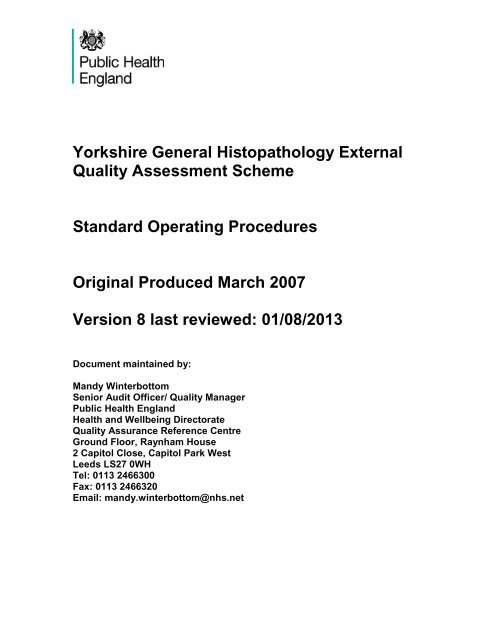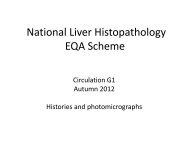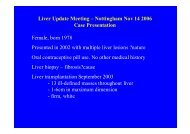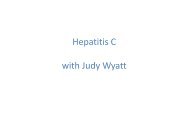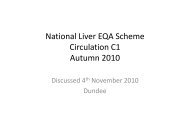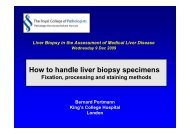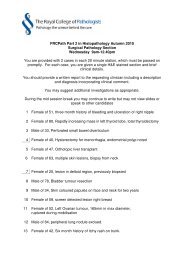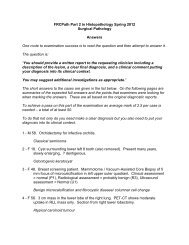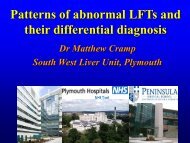SOPs for the Yorkshire General Histopathology EQA Scheme
SOPs for the Yorkshire General Histopathology EQA Scheme
SOPs for the Yorkshire General Histopathology EQA Scheme
- No tags were found...
You also want an ePaper? Increase the reach of your titles
YUMPU automatically turns print PDFs into web optimized ePapers that Google loves.
<strong>Yorkshire</strong> <strong>General</strong> <strong>Histopathology</strong> External<br />
Quality Assessment <strong>Scheme</strong><br />
Standard Operating Procedures<br />
Original Produced March 2007<br />
Version 8 last reviewed: 01/08/2013<br />
Document maintained by:<br />
Mandy Winterbottom<br />
Senior Audit Officer/ Quality Manager<br />
Public Health England<br />
Health and Wellbeing Directorate<br />
Quality Assurance Reference Centre<br />
Ground Floor, Raynham House<br />
2 Capitol Close, Capitol Park West<br />
Leeds LS27 0WH<br />
Tel: 0113 2466300<br />
Fax: 0113 2466320<br />
Email: mandy.winterbottom@nhs.net
STANDARD OPERATING PROCEDURES<br />
CONTENTS<br />
Standard Operating Procedure 1: Identification of Participants ..................... 4<br />
Standard Operating Procedure 2: Movers and Locums ................................. 5<br />
Standard Operating Procedure 3: Enrolment of Participants ......................... 6<br />
Standard Operating Procedure 4: Allocation of Code Numbers ..................... 7<br />
Standard Operating Procedure 5: Identification of Laboratories <strong>for</strong> Slide<br />
Submission .................................................................................................... 8<br />
Standard Operating Procedure 6: Slide Request ........................................... 9<br />
Standard Operating Procedure 7: Dealing with Submitted Broken Slides ... 10<br />
Standard Operating Procedure 8: Organisation of <strong>the</strong> Slide Review Meeting<br />
..................................................................................................................... 11<br />
Standard Operating Procedure 9: Compilation and Labelling of <strong>the</strong> Slide<br />
Sets ............................................................................................................. 12<br />
Standard Operating Procedure 10: Producing <strong>the</strong> Documentation .............. 13<br />
Standard Operating Procedure 11: Setting <strong>the</strong> Dates of <strong>the</strong> Circulation ...... 14<br />
Standard Operating Procedure 12: In<strong>for</strong>ming <strong>the</strong> Participants..................... 15<br />
Standard Operating Procedure 13: Starting <strong>the</strong> Circulation ......................... 16<br />
Standard Operating Procedure 14: Monitoring <strong>the</strong> Slide Set Locations ....... 17<br />
Standard Operating Procedure 15: Slides Broken During <strong>the</strong> Round .......... 18<br />
Standard Operating Procedure 16: Return of Responses ........................... 19<br />
Standard Operating Procedure 17: Late Participation ................................. 20<br />
Standard Operating Procedure 18: Non-Participation .................................. 21<br />
Standard Operating Procedure 19: Entering <strong>the</strong> Participants Responses ... 22<br />
Standard Operating Procedure 20: Initial Case Analysis Results ................ 23<br />
Standard Operating Procedure 21: Participants Meeting ............................. 24<br />
Standard Operating Procedure 22: Final Feedback to Participants ............. 26<br />
Standard Operating Procedure 23: Bottom 2.5th Percentile Calculation ..... 27<br />
Standard Operating Procedure 24: Persistent Substandard Per<strong>for</strong>mance .. 28<br />
Standard Operating Procedure 25: Regional Report ................................... 29<br />
Standard Operating Procedure 26: Storage & Return of Slides ................... 30<br />
Standard Operating Procedure 27: Record Keeping ................................... 31<br />
Standard Operating Procedure 28: Back Up of Computerised Files ............ 32<br />
Standard Operating Procedure 29: Validation ............................................. 33<br />
Standard Operating Procedure 30: Disposal of Records ............................. 34<br />
Standard Operating Procedure 31: Cover <strong>for</strong> Facilitator Leave ................... 35<br />
Standard Operating Procedure 32: Complaints and Revision...................... 36<br />
Standard Operating Procedure 33: Preparation of Standard Operating<br />
Procedures .................................................................................................. 37<br />
Standard Operating Procedure 34: Data Entry ............................................ 38<br />
Standard Operating Procedure 35: Data Retrieval ...................................... 39<br />
Filename: yorkshire histo<br />
eqa sops v8<br />
Version No: 8.0<br />
Date Created:<br />
01/08/2013<br />
Last Revised On:<br />
01/08/2013<br />
Review Date: 08/14 Page 2 of 47 Author: Leeds<br />
Office MW<br />
Authorised By:
STANDARD OPERATING PROCEDURES<br />
Standard Operating Procedure 36: <strong>Scheme</strong> Audit and Monitoring Exercises<br />
..................................................................................................................... 40<br />
Standard Operating Procedure 37: Confidentiality and Data Safety ............ 41<br />
Standard Operating Procedure 38: Document Control ................................ 42<br />
Standard Operating Procedure 39: Audit of <strong>the</strong> Quality Management System<br />
..................................................................................................................... 44<br />
Standard Operating Procedure 40: Quality Improvement ............................ 45<br />
Standard Operating Procedure 41: Committee Meetings/ Annual<br />
Management Review ................................................................................... 46<br />
Standard Operating Procedure 42: O<strong>the</strong>r Non-Con<strong>for</strong>mities Identified (not via<br />
Audits).......................................................................................................... 47<br />
Filename: yorkshire histo<br />
eqa sops v8<br />
Version No: 8.0<br />
Date Created:<br />
01/08/2013<br />
Last Revised On:<br />
01/08/2013<br />
Review Date: 08/14 Page 3 of 47 Author: Leeds<br />
Office MW<br />
Authorised By:
STANDARD OPERATING PROCEDURES<br />
Standard Operating Procedure 1:<br />
Identification of Participants<br />
(CPA Standards: E3, E5)<br />
The scheme is available to those histopathologists who report general surgical<br />
pathology cases within laboratories derived largely from <strong>the</strong> old <strong>Yorkshire</strong><br />
Regional Health Authority area with additional participants from South <strong>Yorkshire</strong>,<br />
Durham, North Tees and Newcastle. This includes consultants, staff grade and<br />
associate specialists who have <strong>the</strong> authority to report independently on material<br />
which is part of <strong>the</strong> scheme. Specialist trainees are encouraged to see <strong>the</strong> cases<br />
and submit written responses.<br />
At <strong>the</strong> start of each round <strong>the</strong> <strong>EQA</strong> <strong>Scheme</strong> Secretary emails <strong>the</strong> lead contact<br />
within each laboratory with a copy of <strong>the</strong> participants list from <strong>the</strong> previous<br />
circulation. The lead is asked to check <strong>for</strong> accuracy and highlight any participants<br />
who wish to join or leave <strong>the</strong> scheme.<br />
Once all <strong>the</strong> amendments are received <strong>the</strong> <strong>Scheme</strong> Secretary creates <strong>the</strong><br />
participants list <strong>for</strong> <strong>the</strong> circulation. Any notable changes such as a participant<br />
leaving or a trainee qualifying are recorded against <strong>the</strong> participant in <strong>the</strong> ‘Record<br />
of Responses.xls’ Excel document.<br />
Filename: yorkshire histo<br />
eqa sops v8<br />
Version No: 8.0<br />
Date Created:<br />
01/08/2013<br />
Last Revised On:<br />
01/08/2013<br />
Review Date: 08/14 Page 4 of 47 Author: Leeds<br />
Office MW<br />
Authorised By:
STANDARD OPERATING PROCEDURES<br />
Standard Operating Procedure 2: Movers and<br />
Locums<br />
(CPA Standards: E3, E5)<br />
Participants who have moved laboratories retain <strong>the</strong>ir individual code. The<br />
<strong>Scheme</strong> Secretary records <strong>the</strong>se changes on <strong>the</strong> ‘Record of Responses.xls’<br />
Excel document. If an individual joins <strong>the</strong> region (as a permanent or locum staff<br />
member) <strong>the</strong> <strong>Scheme</strong> Secretary ascertains if <strong>the</strong>y have previously been a<br />
participant. If this is <strong>the</strong> case <strong>the</strong> participant will be allocated <strong>the</strong>ir original code<br />
to allow follow-up where necessary.<br />
Filename: yorkshire histo<br />
eqa sops v8<br />
Version No: 8.0<br />
Date Created:<br />
01/08/2013<br />
Last Revised On:<br />
01/08/2013<br />
Review Date: 08/14 Page 5 of 47 Author: Leeds<br />
Office MW<br />
Authorised By:
STANDARD OPERATING PROCEDURES<br />
Standard Operating Procedure 3: Enrolment<br />
of Participants<br />
(CPA Standards: E3, E5)<br />
A copy of <strong>the</strong> Participants Manual is sent to all new participants with a<br />
participation <strong>for</strong>m. This participation <strong>for</strong>m must be completed and returned to <strong>the</strong><br />
<strong>Scheme</strong> Secretary prior to <strong>the</strong> allocation of a unique code. All participation <strong>for</strong>ms<br />
are scanned and saved on <strong>the</strong> <strong>EQA</strong> drive.<br />
Filename: yorkshire histo<br />
eqa sops v8<br />
Version No: 8.0<br />
Date Created:<br />
01/08/2013<br />
Last Revised On:<br />
01/08/2013<br />
Review Date: 08/14 Page 6 of 47 Author: Leeds<br />
Office MW<br />
Authorised By:
STANDARD OPERATING PROCEDURES<br />
Standard Operating Procedure 4: Allocation<br />
of Code Numbers<br />
(CPA Standards: E4)<br />
Once a participant has agreed to <strong>the</strong> scheme <strong>the</strong>y will be allocated a unique<br />
participation code, which is known only by <strong>the</strong> participant and <strong>the</strong> <strong>Scheme</strong><br />
Secretary.<br />
The code allocated should be a three number code; <strong>for</strong> Consultant Pathologists it<br />
will be <strong>the</strong> next number in <strong>the</strong> sequence (<strong>for</strong> example if <strong>the</strong> last person to join <strong>the</strong><br />
scheme was participant 192, <strong>the</strong>n <strong>the</strong> next code would be 193). When adding<br />
trainees <strong>the</strong>n <strong>the</strong> code should start 9—(e.g. 901, 902).<br />
When <strong>the</strong> new participant has been allocated a code <strong>the</strong>y are entered onto <strong>the</strong><br />
Name list, Code list and <strong>the</strong> current circulation list in <strong>the</strong> ‘Record of<br />
Responses.xls’ spreadsheet.<br />
Filename: yorkshire histo<br />
eqa sops v8<br />
Version No: 8.0<br />
Date Created:<br />
01/08/2013<br />
Last Revised On:<br />
01/08/2013<br />
Review Date: 08/14 Page 7 of 47 Author: Leeds<br />
Office MW<br />
Authorised By:
STANDARD OPERATING PROCEDURES<br />
Standard Operating Procedure 5:<br />
Identification of Laboratories <strong>for</strong> Slide<br />
Submission<br />
(CPA Standards: D3, E3, E6, F1)<br />
Cases <strong>for</strong> <strong>the</strong> <strong>EQA</strong> are collected on a rotation system. The rota consists of<br />
laboratories grouped toge<strong>the</strong>r based on numbers of participants. Requests <strong>for</strong><br />
submission of cases are made every 12 months from <strong>the</strong> relevant laboratories on<br />
<strong>the</strong> rota, as detailed in <strong>the</strong> ‘Slide Submission Rota.doc’ word document. Each<br />
participant is required to submit a minimum of two cases during <strong>the</strong>ir laboratory’s<br />
scheduled turn on <strong>the</strong> rota in order to maintain <strong>the</strong> slide bank with an adequate<br />
number of cases <strong>for</strong> annual review and selection.<br />
Filename: yorkshire histo<br />
eqa sops v8<br />
Version No: 8.0<br />
Date Created:<br />
01/08/2013<br />
Last Revised On:<br />
01/08/2013<br />
Review Date: 08/14 Page 8 of 47 Author: Leeds<br />
Office MW<br />
Authorised By:
STANDARD OPERATING PROCEDURES<br />
Standard Operating Procedure 6: Slide<br />
Request<br />
(CPA Standards: A4, A9, A10, D3, F1)<br />
The <strong>Scheme</strong> Secretary will request cases on a yearly basis from participants in<br />
<strong>the</strong> relevant laboratories identified in <strong>the</strong> ‘Slide Submission Rota.doc’ word<br />
document who are eligible to submit cases. The ‘Slide Request Letter’ requesting<br />
that <strong>the</strong>y submit a minimum of two cases (12 H&E stained slides from one block<br />
of each case) along with <strong>the</strong> ‘<strong>EQA</strong> clinical info template’ <strong>for</strong>m and <strong>the</strong> ‘<strong>EQA</strong><br />
diagnosis template’ is emailed to <strong>the</strong> participants.<br />
They are asked to submit cases which are appropriate to a general<br />
histopathology scheme. These should cover all <strong>the</strong> main organ systems and<br />
specialities likely to be seen by a general histopathologist in a district general<br />
hospital as part of <strong>the</strong> routine workload. Specialised neuropathology, paediatric<br />
pathology, orthopaedic pathology, ophthalmic pathology, dental pathology, and<br />
renal biopsy pathology would normally be excluded. Post mortem cases are not<br />
accepted.<br />
For each case <strong>the</strong> participant is asked to provide <strong>the</strong> following:<br />
<br />
<br />
<br />
<br />
<br />
<br />
<br />
<br />
Case provided by<br />
Specimen<br />
Your case number<br />
Macroscopic Description<br />
Clinical In<strong>for</strong>mation (including special stains etc.)<br />
Age<br />
Sex<br />
Your diagnosis<br />
The participants are in<strong>for</strong>med that slides and accompanying in<strong>for</strong>mation sent to<br />
<strong>the</strong> QARC should not have visible patient identifiers. The cases will be relabelled<br />
as necessary during <strong>the</strong> circulations to ensure <strong>the</strong>re are no details which could<br />
disclose <strong>the</strong> origin of <strong>the</strong> case.<br />
For all slides <strong>the</strong> submitted in<strong>for</strong>mation is recorded in <strong>the</strong> ‘Slide Selection’ Excel<br />
document, to allow <strong>the</strong>m to be located at any time. This in<strong>for</strong>mation should be<br />
kept according to SOP 38: Document Control. The cases details <strong>for</strong>ms and<br />
diagnosis in<strong>for</strong>mation should be kept separately.<br />
Filename: yorkshire histo<br />
eqa sops v8<br />
Version No: 8.0<br />
Date Created:<br />
01/08/2013<br />
Last Revised On:<br />
01/08/2013<br />
Review Date: 08/14 Page 9 of 47 Author: Leeds<br />
Office MW<br />
Authorised By:
STANDARD OPERATING PROCEDURES<br />
Standard Operating Procedure 7: Dealing<br />
with Submitted Broken Slides<br />
(CPA Standards: A4, A10, C4, D3, F1)<br />
If a slide is broken in transport <strong>the</strong> <strong>EQA</strong> <strong>Scheme</strong> Secretary contacts <strong>the</strong><br />
participant to arrange return of <strong>the</strong> slide. Depending on <strong>the</strong> level of damage <strong>the</strong><br />
slide may be returned by hand.<br />
The <strong>EQA</strong> <strong>Scheme</strong> Secretary records details of any cases which have been<br />
returned with an explanation in <strong>the</strong> database and <strong>the</strong> ‘Slide Selection’ Excel<br />
document.<br />
Filename: yorkshire histo<br />
eqa sops v8<br />
Version No: 8.0<br />
Date Created:<br />
01/08/2013<br />
Last Revised On:<br />
01/08/2013<br />
Review Date: 08/14 Page 10 of 47 Author: Leeds<br />
Office MW<br />
Authorised By:
STANDARD OPERATING PROCEDURES<br />
Standard Operating Procedure 8:<br />
Organisation of <strong>the</strong> Slide Review Meeting<br />
(CPA Standards: A4, F1)<br />
Upon receipt of slides, <strong>the</strong> <strong>EQA</strong> <strong>Scheme</strong> Secretary checks over all slides<br />
submitted <strong>for</strong> each case to ensure that <strong>the</strong>re is a similar amount of material in<br />
each slide. The Secretary arranges a date suitable <strong>for</strong> all members of <strong>the</strong><br />
<strong>Scheme</strong> Organising Committee to attend (Prior to <strong>the</strong> slide review an Organising<br />
Committee meeting is usually held).<br />
The Committee members assess all submitted cases <strong>for</strong> suitability including<br />
whe<strong>the</strong>r adequate clinical in<strong>for</strong>mation, immunocytochemistry and special stains<br />
have been provided.<br />
The <strong>Scheme</strong> Secretary records <strong>the</strong> opinions of <strong>the</strong> Organising Committee<br />
including those cases which should appear in different circulations. During <strong>the</strong><br />
slide review <strong>the</strong> Committee may select a number of cases to be included as<br />
Educational Cases against which <strong>the</strong> participant will not be scored. The <strong>Scheme</strong><br />
Organiser <strong>the</strong>n conducts a microscopic check on all slides <strong>for</strong> <strong>the</strong> cases deemed<br />
suitable <strong>for</strong> <strong>the</strong> <strong>EQA</strong> and records this on <strong>the</strong> ‘<strong>EQA</strong> Clinical In<strong>for</strong>mation’ <strong>for</strong>m <strong>for</strong><br />
each case.<br />
Following <strong>the</strong> review <strong>the</strong> <strong>Scheme</strong> Secretary updates <strong>the</strong> ‘Slide Selection’ Excel<br />
document.<br />
Filename: yorkshire histo<br />
eqa sops v8<br />
Version No: 8.0<br />
Date Created:<br />
01/08/2013<br />
Last Revised On:<br />
01/08/2013<br />
Review Date: 08/14 Page 11 of 47 Author: Leeds<br />
Office MW<br />
Authorised By:
STANDARD OPERATING PROCEDURES<br />
Standard Operating Procedure 9:<br />
Compilation and Labelling of <strong>the</strong> Slide Sets<br />
(CPA Standards: A4, A10, C4, D3, E3, E4, F1, F2)<br />
At <strong>the</strong> beginning of each circulation, <strong>the</strong> <strong>Scheme</strong> Secretary selects 10 cases from<br />
<strong>the</strong> cases deemed suitable by <strong>the</strong> Committee. It is <strong>the</strong> responsibility of <strong>the</strong><br />
Secretary to assemble <strong>the</strong> slide sets and to ensure that <strong>the</strong> diagnoses are not in<br />
duplicate.<br />
The cases to be included in <strong>the</strong> circulation are marked with a circulation letter<br />
and a unique circulation number. The letter allocated to <strong>the</strong> circulation is <strong>the</strong> next<br />
in <strong>the</strong> alphabet (e.g. <strong>the</strong> last circulation was H so <strong>the</strong> next sets will be I). Each<br />
case is given a three digit number; <strong>the</strong> first number is specific to <strong>the</strong> circulation<br />
with <strong>the</strong> next two relating to <strong>the</strong> case number, 00 to 09. The circulation number<br />
increases by one from <strong>the</strong> previous circulation e.g. <strong>for</strong> circulation H <strong>the</strong> cases<br />
were 700 to 709 so circulation I will be 800 to 809. For each case, <strong>the</strong> case<br />
details including <strong>the</strong> diagnosis need to be entered into <strong>the</strong> Omnis7 Genpath<br />
library.<br />
When <strong>the</strong> <strong>Scheme</strong> Organiser has checked and approved <strong>the</strong> cases <strong>the</strong> <strong>Scheme</strong><br />
Secretary re-labels <strong>the</strong> slides with <strong>the</strong> new three digit number, and makes up<br />
twelve slide sets. Each slide set should contain one slide from each case (ten<br />
slides in each set). Slide sets are <strong>the</strong>n numbered from set 1 to set 12. The<br />
laboratories are allocated a slide set, which allows <strong>the</strong> identification of any<br />
problems with sets if necessary.<br />
As cases consist of permanent non-degradable slides (stored in appropriate<br />
boxes within a lockable cabinet) unused appropriate cases can be used during<br />
circulations held within two years of submission.<br />
Filename: yorkshire histo<br />
eqa sops v8<br />
Version No: 8.0<br />
Date Created:<br />
01/08/2013<br />
Last Revised On:<br />
01/08/2013<br />
Review Date: 08/14 Page 12 of 47 Author: Leeds<br />
Office MW<br />
Authorised By:
STANDARD OPERATING PROCEDURES<br />
Standard Operating Procedure 10: Producing<br />
<strong>the</strong> Documentation<br />
(CPA Standards: A4, A9, F2)<br />
The response <strong>for</strong>ms are produced by <strong>the</strong> <strong>Scheme</strong> Secretary using <strong>the</strong> ‘Response<br />
Sheet Template’ Excel document. The response <strong>for</strong>ms are <strong>the</strong>n sent via email to<br />
<strong>the</strong> <strong>Scheme</strong> Organiser <strong>for</strong> checking.<br />
The <strong>Scheme</strong> Secretary records <strong>the</strong> case circulation number on <strong>the</strong> original<br />
submitted cases details and diagnosis <strong>for</strong>ms. These are held in a lockable<br />
cabinet accessible only by <strong>the</strong> <strong>Scheme</strong> Secretary.<br />
Filename: yorkshire histo<br />
eqa sops v8<br />
Version No: 8.0<br />
Date Created:<br />
01/08/2013<br />
Last Revised On:<br />
01/08/2013<br />
Review Date: 08/14 Page 13 of 47 Author: Leeds<br />
Office MW<br />
Authorised By:
STANDARD OPERATING PROCEDURES<br />
Standard Operating Procedure 11: Setting<br />
<strong>the</strong> Dates of <strong>the</strong> Circulation<br />
(CPA Standards: E4)<br />
The <strong>Yorkshire</strong> <strong>General</strong> <strong>Histopathology</strong> <strong>EQA</strong> scheme holds two circulations per<br />
year. These are in Spring and Autumn. Prior to <strong>the</strong> circulation <strong>the</strong> <strong>EQA</strong> <strong>Scheme</strong><br />
Secretary identifies periods which should be avoided such as school holiday<br />
periods. The circulations take place over a five week period (usually<br />
February/March and September/October). Once <strong>the</strong> period has been identified<br />
<strong>the</strong> <strong>EQA</strong> <strong>Scheme</strong> Secretary will in<strong>for</strong>m <strong>the</strong> <strong>Scheme</strong> Organising Committee via<br />
email and if appropriate, discuss at <strong>the</strong> Committee meeting.<br />
There are 12 sets which can be circulated to <strong>the</strong> laboratories within <strong>the</strong> scheme.<br />
Those laboratories with larger numbers of participants will receive a set <strong>for</strong> <strong>the</strong><br />
entire four weeks. A number of sets will be sent to laboratories <strong>for</strong> part of <strong>the</strong><br />
circulation with instructions to <strong>for</strong>ward on to <strong>the</strong> next laboratory on a set date.<br />
A calendar is prepared <strong>for</strong> each circulation (using <strong>the</strong> ‘Circulation Schedule<br />
Template’ Word document) which states, by slide set, <strong>the</strong> date <strong>the</strong> slides are<br />
available in each laboratory.<br />
Filename: yorkshire histo<br />
eqa sops v8<br />
Version No: 8.0<br />
Date Created:<br />
01/08/2013<br />
Last Revised On:<br />
01/08/2013<br />
Review Date: 08/14 Page 14 of 47 Author: Leeds<br />
Office MW<br />
Authorised By:
STANDARD OPERATING PROCEDURES<br />
Standard Operating Procedure 12: In<strong>for</strong>ming<br />
<strong>the</strong> Participants<br />
(CPA Standards: E4)<br />
Prior to <strong>the</strong> circulation <strong>the</strong> <strong>EQA</strong> <strong>Scheme</strong> Secretary sends <strong>the</strong> ‘Starting <strong>the</strong><br />
circulation - Prestart Letter’ to all participants to notify <strong>the</strong>m of <strong>the</strong> dates <strong>the</strong> slides<br />
will be available in <strong>the</strong>ir laboratory; this should occur a minimum of one month<br />
prior to <strong>the</strong> start of <strong>the</strong> round. In this letter <strong>the</strong> Secretary asks <strong>the</strong> participant to<br />
contact <strong>the</strong>m if <strong>the</strong>y do not wish to participate or with any reasons <strong>for</strong> nonparticipation.<br />
Filename: yorkshire histo<br />
eqa sops v8<br />
Version No: 8.0<br />
Date Created:<br />
01/08/2013<br />
Last Revised On:<br />
01/08/2013<br />
Review Date: 08/14 Page 15 of 47 Author: Leeds<br />
Office MW<br />
Authorised By:
STANDARD OPERATING PROCEDURES<br />
Standard Operating Procedure 13: Starting<br />
<strong>the</strong> Circulation<br />
(CPA Standards: E4, F2)<br />
The week prior to <strong>the</strong> start of <strong>the</strong> circulation <strong>the</strong> <strong>EQA</strong> <strong>Scheme</strong> Secretary sends all<br />
participants <strong>the</strong>ir response <strong>for</strong>ms electronically via email with <strong>the</strong> calendar.<br />
Also in <strong>the</strong> week prior to <strong>the</strong> circulation <strong>the</strong> Secretary prepares <strong>the</strong> ‘Starting <strong>the</strong><br />
circulation - Lab Coordinator Letters’ <strong>for</strong> each laboratory. There are two letters<br />
sent at this point. The first is to those laboratories where <strong>the</strong> slides are due on <strong>the</strong><br />
first day of <strong>the</strong> circulation. The letter contains a slide set and details (including an<br />
envelope label) of where and when <strong>the</strong> slides are to be sent to <strong>the</strong> next location.<br />
The second letter goes to those laboratories who receive slides part way through<br />
<strong>the</strong> circulation. This states <strong>the</strong> date <strong>the</strong> slides will arrive and details if applicable<br />
(including an envelope label) of where and when <strong>the</strong> slides are to be sent to <strong>the</strong><br />
next location.<br />
Filename: yorkshire histo<br />
eqa sops v8<br />
Version No: 8.0<br />
Date Created:<br />
01/08/2013<br />
Last Revised On:<br />
01/08/2013<br />
Review Date: 08/14 Page 16 of 47 Author: Leeds<br />
Office MW<br />
Authorised By:
STANDARD OPERATING PROCEDURES<br />
Standard Operating Procedure 14:<br />
Monitoring <strong>the</strong> Slide Set Locations<br />
(CPA Standards: A4, A9, A10, D3, E4, F1)<br />
The <strong>Scheme</strong> Secretary contacts via email <strong>the</strong> lead contact in <strong>the</strong> laboratory on<br />
<strong>the</strong> date <strong>the</strong> slides are due to arrive to confirm receipt. If <strong>the</strong> slides have not<br />
arrived <strong>the</strong> <strong>Scheme</strong> Secretary contacts <strong>the</strong> previous laboratory to check that <strong>the</strong>y<br />
have <strong>for</strong>warded <strong>the</strong> slides.<br />
A spare set of slides <strong>for</strong> each circulation is retained at <strong>the</strong> Quality Assurance<br />
Reference Centre <strong>for</strong> future reference. These are stored in a slide bank in a<br />
locked, cool room.<br />
Filename: yorkshire histo<br />
eqa sops v8<br />
Version No: 8.0<br />
Date Created:<br />
01/08/2013<br />
Last Revised On:<br />
01/08/2013<br />
Review Date: 08/14 Page 17 of 47 Author: Leeds<br />
Office MW<br />
Authorised By:
STANDARD OPERATING PROCEDURES<br />
Standard Operating Procedure 15: Slides<br />
Broken During <strong>the</strong> Round<br />
(CPA Standards: A10, D3, E4, F1)<br />
If slides are damaged or broken beyond repair in a round <strong>the</strong>n <strong>the</strong> slide set will<br />
be removed from <strong>the</strong> circulation and those who have not completed responses<br />
will be given ano<strong>the</strong>r set.<br />
Broken slides will be passed to <strong>the</strong> <strong>Scheme</strong> Organiser <strong>for</strong> secure disposal.<br />
Filename: yorkshire histo<br />
eqa sops v8<br />
Version No: 8.0<br />
Date Created:<br />
01/08/2013<br />
Last Revised On:<br />
01/08/2013<br />
Review Date: 08/14 Page 18 of 47 Author: Leeds<br />
Office MW<br />
Authorised By:
STANDARD OPERATING PROCEDURES<br />
Standard Operating Procedure 16: Return of<br />
Responses<br />
(CPA Standards: A9, E4, F3)<br />
The participants are encouraged to return <strong>the</strong>ir responses at <strong>the</strong> earliest<br />
opportunity, via email to <strong>the</strong> <strong>Scheme</strong> Secretary. When <strong>the</strong> Secretary receives <strong>the</strong><br />
response <strong>the</strong> unique identifiable code and <strong>the</strong> ‘record of responses.xls’, are used<br />
to identify <strong>the</strong> individual. The <strong>Scheme</strong> Secretary <strong>the</strong>n records that <strong>the</strong> responses<br />
have been received on <strong>the</strong> ‘record of responses.xls’ Excel spreadsheet. The<br />
response <strong>for</strong>ms are <strong>the</strong>n filed electronically by code on <strong>the</strong> <strong>EQA</strong> drive.<br />
Two weeks after <strong>the</strong> end of <strong>the</strong> circulation <strong>the</strong> <strong>Scheme</strong> Secretary writes to those<br />
participants who have not submitted response <strong>for</strong>ms requesting that <strong>the</strong>se are<br />
sent within two weeks. A note is made on <strong>the</strong> ‘record of responses.xls’ of <strong>the</strong> date<br />
<strong>the</strong> reminders were sent.<br />
Filename: yorkshire histo<br />
eqa sops v8<br />
Version No: 8.0<br />
Date Created:<br />
01/08/2013<br />
Last Revised On:<br />
01/08/2013<br />
Review Date: 08/14 Page 19 of 47 Author: Leeds<br />
Office MW<br />
Authorised By:
STANDARD OPERATING PROCEDURES<br />
Standard Operating Procedure 17: Late<br />
Participation<br />
(CPA Standards: E5, F3)<br />
Response <strong>for</strong>ms received after <strong>the</strong> initial results have been produced, but prior to<br />
<strong>the</strong>ir circulation are entered in to <strong>the</strong> system, but not included in <strong>the</strong> scoring <strong>for</strong><br />
discussion at <strong>the</strong> meeting. Those response <strong>for</strong>ms received after <strong>the</strong> initial results<br />
have been circulated will not be entered and <strong>the</strong> participant will be recorded as<br />
not participating. These will be retained with an explanation being recorded on<br />
<strong>the</strong>‘record of responses.xls’ Excel spreadsheet.<br />
If a participant chooses to submit additional/amended results <strong>the</strong>se will not be<br />
accepted <strong>for</strong> scoring, but will be retained with <strong>the</strong> original response sheets.<br />
Filename: yorkshire histo<br />
eqa sops v8<br />
Version No: 8.0<br />
Date Created:<br />
01/08/2013<br />
Last Revised On:<br />
01/08/2013<br />
Review Date: 08/14 Page 20 of 47 Author: Leeds<br />
Office MW<br />
Authorised By:
STANDARD OPERATING PROCEDURES<br />
Standard Operating Procedure 18: Non-<br />
Participation<br />
(CPA Standards: E5, F3)<br />
Acceptable reasons <strong>for</strong> staff not participating are long term ill health and<br />
maternity leave. When considering instances of ill health, each case should be<br />
looked at individually and decisions based on common sense. For example, if an<br />
individual has a serious illness <strong>the</strong>n non-participation is acceptable; however, if a<br />
participant is only ever absent on/around <strong>the</strong> circulation dates <strong>the</strong>n this is not<br />
acceptable.<br />
Failure to participate in two out of three rounds will be reported by <strong>the</strong> <strong>Scheme</strong><br />
Secretary to <strong>the</strong> <strong>Scheme</strong> Organising Committee. They will <strong>the</strong>n write to <strong>the</strong><br />
participant to ask if <strong>the</strong>y wish to continue participating.<br />
Filename: yorkshire histo<br />
eqa sops v8<br />
Version No: 8.0<br />
Date Created:<br />
01/08/2013<br />
Last Revised On:<br />
01/08/2013<br />
Review Date: 08/14 Page 21 of 47 Author: Leeds<br />
Office MW<br />
Authorised By:
STANDARD OPERATING PROCEDURES<br />
Standard Operating Procedure 19: Entering<br />
<strong>the</strong> Participants Responses<br />
(CPA Standards: F3, F4)<br />
Following <strong>the</strong> initiation of <strong>the</strong> circulation <strong>the</strong> <strong>Scheme</strong> Secretary copies <strong>the</strong><br />
relevant CLINICAL.DAT file onto <strong>the</strong> <strong>Scheme</strong> Organiser’s version of <strong>the</strong> Omnis7<br />
database.<br />
When <strong>the</strong> <strong>Scheme</strong> Organiser has returned <strong>the</strong>ir responses he/she can begin to<br />
enter <strong>the</strong> results into <strong>the</strong> Omnis7 database. The <strong>Scheme</strong> Secretary provides <strong>the</strong><br />
<strong>Scheme</strong> Organiser with <strong>the</strong> received responses in a non-identifiable manner <strong>for</strong><br />
data entry.<br />
When all results have been entered and <strong>the</strong> amalgamations decided at <strong>the</strong><br />
participants meeting have been conducted a copy of <strong>the</strong> consultants file is<br />
created into which <strong>the</strong> trainee results are entered. This allows <strong>the</strong> trainees to<br />
compare <strong>the</strong>ir results to consultants without <strong>the</strong>m being included in <strong>the</strong> final<br />
scoring.<br />
Filename: yorkshire histo<br />
eqa sops v8<br />
Version No: 8.0<br />
Date Created:<br />
01/08/2013<br />
Last Revised On:<br />
01/08/2013<br />
Review Date: 08/14 Page 22 of 47 Author: Leeds<br />
Office MW<br />
Authorised By:
STANDARD OPERATING PROCEDURES<br />
Standard Operating Procedure 20: Initial<br />
Case Analysis Results<br />
(CPA Standards: E4, F4, F5)<br />
Following <strong>the</strong> entering of <strong>the</strong> responses <strong>the</strong> <strong>Scheme</strong> Secretary prints <strong>the</strong> Initial<br />
Case Analysis results from Omnis7. These are circulated to all participants <strong>the</strong><br />
week prior to <strong>the</strong> participants meeting via email.<br />
Filename: yorkshire histo<br />
eqa sops v8<br />
Version No: 8.0<br />
Date Created:<br />
01/08/2013<br />
Last Revised On:<br />
01/08/2013<br />
Review Date: 08/14 Page 23 of 47 Author: Leeds<br />
Office MW<br />
Authorised By:
STANDARD OPERATING PROCEDURES<br />
Standard Operating Procedure 21:<br />
Participants Meeting<br />
(CPA Standards: A2, E5, F4, G1, G2, H1)<br />
A participants meeting is held at <strong>the</strong> end of each round in conjunction with <strong>the</strong><br />
<strong>Yorkshire</strong> Histopathologists Business Meeting. At <strong>the</strong> earliest possible<br />
opportunity <strong>the</strong> <strong>Scheme</strong> Secretary should write to <strong>the</strong> participants with <strong>the</strong> date of<br />
this meeting. The intention of <strong>the</strong> meeting is to allow participants to discuss:<br />
1. The general management of <strong>the</strong> scheme and any way in which <strong>the</strong><br />
scheme may be extended, improved and audited.<br />
2. The cases which have been circulated since <strong>the</strong> previous<br />
participants’ meeting, in order to decide how best <strong>the</strong>y should be<br />
used <strong>for</strong> personal analysis.<br />
The submitting pathologists are asked to present <strong>the</strong> educational cases at <strong>the</strong><br />
participants meeting; this is expected to be a short explanation <strong>for</strong> <strong>the</strong> diagnosis<br />
given, including photographs of <strong>the</strong> relevant areas within <strong>the</strong> slide. The <strong>Scheme</strong><br />
Secretary should ensure that <strong>the</strong> required equipment is available at <strong>the</strong> meeting.<br />
The <strong>Scheme</strong> Secretary writes to <strong>the</strong> participants providing a copy of <strong>the</strong> initial<br />
case analysis and asking <strong>the</strong>m to confirm attendance. For <strong>the</strong> participants<br />
meeting to be valid <strong>the</strong> quorum (~ 30%) must be met. An attendance register<br />
should be completed, and minutes of <strong>the</strong> meeting are produced and sent to all<br />
participants.<br />
Participants present at <strong>the</strong> meeting are asked to decide:<br />
1. Whe<strong>the</strong>r each case is appropriate <strong>for</strong> <strong>the</strong> scheme.<br />
2. How/If <strong>the</strong> responses should be amalgamated <strong>for</strong> <strong>the</strong> final results.<br />
Following <strong>the</strong> meeting <strong>the</strong> <strong>Scheme</strong> Secretary will record on <strong>the</strong> ‘Attendance at<br />
Part Meeting Audit.xls’ those who attended. The spread sheet calculates those<br />
participants who have not attended a meeting within <strong>the</strong> previous three<br />
circulations, which is recommended as good practice.<br />
Filename: yorkshire histo<br />
eqa sops v8<br />
Version No: 8.0<br />
Date Created:<br />
01/08/2013<br />
Last Revised On:<br />
01/08/2013<br />
Review Date: 08/14 Page 24 of 47 Author: Leeds<br />
Office MW<br />
Authorised By:
STANDARD OPERATING PROCEDURES<br />
Any feedback from CPA or <strong>the</strong> Royal College of Pathologists is communicated to<br />
<strong>the</strong> group at <strong>the</strong> participants meeting. If a complaint or suggestion <strong>for</strong> altering <strong>the</strong><br />
scheme is made at <strong>the</strong> meeting, it is taken to <strong>the</strong> next <strong>Scheme</strong> Organising<br />
Committee <strong>for</strong> discussion.<br />
Filename: yorkshire histo<br />
eqa sops v8<br />
Version No: 8.0<br />
Date Created:<br />
01/08/2013<br />
Last Revised On:<br />
01/08/2013<br />
Review Date: 08/14 Page 25 of 47 Author: Leeds<br />
Office MW<br />
Authorised By:
STANDARD OPERATING PROCEDURES<br />
Standard Operating Procedure 22: Final<br />
Feedback to Participants<br />
(CPA Standards: F5)<br />
Following <strong>the</strong> decisions made at <strong>the</strong> Participants Meeting, <strong>the</strong> <strong>Scheme</strong> Secretary<br />
per<strong>for</strong>ms <strong>the</strong> amalgamations agreed and produces <strong>the</strong> final results <strong>for</strong> all<br />
participants.<br />
The <strong>Scheme</strong> Secretary <strong>the</strong>n produces <strong>the</strong> final result packs which include:<br />
<br />
<br />
<br />
Individual Results<br />
Certificate of Participation<br />
Minutes of <strong>the</strong> Participant Meeting<br />
These are circulated within one month of <strong>the</strong> participant meeting.<br />
Filename: yorkshire histo<br />
eqa sops v8<br />
Version No: 8.0<br />
Date Created:<br />
01/08/2013<br />
Last Revised On:<br />
01/08/2013<br />
Review Date: 08/14 Page 26 of 47 Author: Leeds<br />
Office MW<br />
Authorised By:
STANDARD OPERATING PROCEDURES<br />
Standard Operating Procedure 23: Bottom<br />
2.5th Percentile Calculation<br />
(CPA Standards: E4, E5, F4)<br />
The Omnis7 database calculates those participants who have scored below <strong>the</strong><br />
2.5 percentile. These are <strong>the</strong>n recorded on <strong>the</strong> ‘Poor Per<strong>for</strong>mer & Non-part.xls’<br />
spread sheet.<br />
Due to <strong>the</strong> nature of <strong>the</strong> scoring system, on some occasions <strong>the</strong>re may be a<br />
number of individuals whose scores equal <strong>the</strong> 2.5 percentile point, with no score<br />
falling below <strong>the</strong> value. In <strong>the</strong>se cases no participants can be identified as<br />
substandard per<strong>for</strong>mers.<br />
Filename: yorkshire histo<br />
eqa sops v8<br />
Version No: 8.0<br />
Date Created:<br />
01/08/2013<br />
Last Revised On:<br />
01/08/2013<br />
Review Date: 08/14 Page 27 of 47 Author: Leeds<br />
Office MW<br />
Authorised By:
STANDARD OPERATING PROCEDURES<br />
Standard Operating Procedure 24: Persistent<br />
Substandard Per<strong>for</strong>mance<br />
(CPA Standards: E2, E4, E5, F4)<br />
Persistent substandard per<strong>for</strong>mance is identified when a participant scores below<br />
<strong>the</strong> 2.5 percentile mark twice within three circulations. Following <strong>the</strong> identification<br />
of those falling below <strong>the</strong> 2.5 percentile mark <strong>the</strong> <strong>Scheme</strong> Secretary checks if any<br />
of <strong>the</strong>se individuals have scored below this mark in ei<strong>the</strong>r of <strong>the</strong> two preceding<br />
circulations.<br />
If a persistent substandard per<strong>for</strong>mer is identified, <strong>the</strong> <strong>Scheme</strong> Organiser sends a<br />
“Dear Colleague” letter to <strong>the</strong> participant, through <strong>the</strong> <strong>Scheme</strong> Secretary to<br />
maintain anonymity. This includes a copy of <strong>the</strong>ir results <strong>for</strong> <strong>the</strong> circulations<br />
where <strong>the</strong>y scored below <strong>the</strong> 2.5 percentile mark. The intention of <strong>the</strong> letter is to<br />
offer appropriate advice and assistance and to in<strong>for</strong>m <strong>the</strong> participant that if <strong>the</strong><br />
score results in a similar ranking in two out of <strong>the</strong> next three circulations, <strong>the</strong><br />
Chairman of <strong>the</strong> NQAAP will have to be asked to investigate. It should also be<br />
made clear that <strong>for</strong> <strong>the</strong> next three circulations, a failure to participate will be<br />
considered to be a score of zero. This letter should be sent within one month<br />
following <strong>the</strong> distribution of <strong>the</strong> final results.<br />
The participant is asked to confirm that this letter has been received, by reply<br />
through <strong>the</strong> <strong>Scheme</strong> Secretary, bearing no identifying marks o<strong>the</strong>r than <strong>the</strong><br />
participant’s code number. If this is not received within three weeks, <strong>the</strong> <strong>Scheme</strong><br />
Organiser sends a reminder; if a reply is not received within ano<strong>the</strong>r three weeks<br />
<strong>the</strong>y are <strong>the</strong>n required to in<strong>for</strong>m <strong>the</strong> NQAAP Chairman of <strong>the</strong> position. This letter<br />
is identified by <strong>the</strong> participant’s number managed through <strong>the</strong> <strong>Scheme</strong> Secretary.<br />
Filename: yorkshire histo<br />
eqa sops v8<br />
Version No: 8.0<br />
Date Created:<br />
01/08/2013<br />
Last Revised On:<br />
01/08/2013<br />
Review Date: 08/14 Page 28 of 47 Author: Leeds<br />
Office MW<br />
Authorised By:
STANDARD OPERATING PROCEDURES<br />
Standard Operating Procedure 25: Regional<br />
Report<br />
(CPA Standards: A2, A5)<br />
The <strong>Scheme</strong> Secretary compiles an annual report containing relevant in<strong>for</strong>mation<br />
relating to <strong>the</strong> year period. These include; <strong>the</strong> circulations, changes to staffing,<br />
CPA applications and internal audits. The report is produced by calendar year<br />
and is made available to <strong>the</strong> scheme participants through <strong>the</strong> Virtual Pathology<br />
website.<br />
A separate report is produced <strong>for</strong> <strong>the</strong> Royal College of Pathologists in<br />
accordance with <strong>the</strong> template circulated each year.<br />
Filename: yorkshire histo<br />
eqa sops v8<br />
Version No: 8.0<br />
Date Created:<br />
01/08/2013<br />
Last Revised On:<br />
01/08/2013<br />
Review Date: 08/14 Page 29 of 47 Author: Leeds<br />
Office MW<br />
Authorised By:
STANDARD OPERATING PROCEDURES<br />
Standard Operating Procedure 26: Storage &<br />
Return of Slides<br />
(CPA Standards: A4, A9, A10, D3)<br />
At <strong>the</strong> end of each circulation, <strong>the</strong> slide sets are retained indefinitely by <strong>the</strong> last<br />
laboratory to receive <strong>the</strong>m <strong>for</strong> educational purposes. The schedule is organised<br />
so that <strong>the</strong> teaching hospitals are usually last in <strong>the</strong> circulation <strong>for</strong> this reason.<br />
One slide set is retained by <strong>the</strong> QA Reference Centre <strong>for</strong> audit purposes. These<br />
are stored in solid slide containers in a secure locked room with restricted fob<br />
access. Cases are filed in slide sets by circulation.<br />
If a participant requests a case to be returned <strong>the</strong> <strong>Scheme</strong> Secretary is obliged to<br />
do so. The facilitator must record details of <strong>the</strong> date <strong>the</strong> case was returned and<br />
<strong>the</strong> reason <strong>for</strong> doing so. If <strong>the</strong> case is part of a set it should be removed from<br />
scoring and counted as not being suitable <strong>for</strong> <strong>EQA</strong>.<br />
Filename: yorkshire histo<br />
eqa sops v8<br />
Version No: 8.0<br />
Date Created:<br />
01/08/2013<br />
Last Revised On:<br />
01/08/2013<br />
Review Date: 08/14 Page 30 of 47 Author: Leeds<br />
Office MW<br />
Authorised By:
STANDARD OPERATING PROCEDURES<br />
Standard Operating Procedure 27: Record<br />
Keeping<br />
(CPA Standards: A4, A9, D2)<br />
It is <strong>the</strong> <strong>Scheme</strong> Secretary’s responsibility to keep accurate records and<br />
documentation. All written communication should be kept according to SOP 38:<br />
Document Control. All documentation is stored electronically or in a locked<br />
cabinet which is only accessible by <strong>the</strong> <strong>Scheme</strong> Secretary.<br />
Filename: yorkshire histo<br />
eqa sops v8<br />
Version No: 8.0<br />
Date Created:<br />
01/08/2013<br />
Last Revised On:<br />
01/08/2013<br />
Review Date: 08/14 Page 31 of 47 Author: Leeds<br />
Office MW<br />
Authorised By:
STANDARD OPERATING PROCEDURES<br />
Standard Operating Procedure 28: Back Up<br />
of Computerised Files<br />
(CPA Standards: A4, A9, D2)<br />
All computerised files are stored on <strong>the</strong> Quality Assurance Reference Centre<br />
server on <strong>the</strong> relevant secured shared drive. The server is fully backed up weekly<br />
locally and to ano<strong>the</strong>r site with incremental local back up nightly.<br />
Filename: yorkshire histo<br />
eqa sops v8<br />
Version No: 8.0<br />
Date Created:<br />
01/08/2013<br />
Last Revised On:<br />
01/08/2013<br />
Review Date: 08/14 Page 32 of 47 Author: Leeds<br />
Office MW<br />
Authorised By:
STANDARD OPERATING PROCEDURES<br />
Standard Operating Procedure 29: Validation<br />
(CPA Standards: A4, A9, D2, E4, F4)<br />
The <strong>Scheme</strong> Secretary per<strong>for</strong>ms <strong>the</strong> validation audit on ten percent of <strong>the</strong><br />
entered results prior to circulating <strong>the</strong> final results. This audit is retained <strong>for</strong> a<br />
period of ten years, and is accessible when required.<br />
Filename: yorkshire histo<br />
eqa sops v8<br />
Version No: 8.0<br />
Date Created:<br />
01/08/2013<br />
Last Revised On:<br />
01/08/2013<br />
Review Date: 08/14 Page 33 of 47 Author: Leeds<br />
Office MW<br />
Authorised By:
STANDARD OPERATING PROCEDURES<br />
Standard Operating Procedure 30: Disposal<br />
of Records<br />
(CPA Standards: A4, A9, D2)<br />
All records must be kept <strong>for</strong> a minimum of ten years. Due to <strong>the</strong> confidentiality<br />
associated with <strong>the</strong> scheme all records which are to be disposed of must be<br />
treated in <strong>the</strong> required manner. Paper documents must be shredded in house by<br />
<strong>the</strong> <strong>Scheme</strong> Secretary.<br />
Filename: yorkshire histo<br />
eqa sops v8<br />
Version No: 8.0<br />
Date Created:<br />
01/08/2013<br />
Last Revised On:<br />
01/08/2013<br />
Review Date: 08/14 Page 34 of 47 Author: Leeds<br />
Office MW<br />
Authorised By:
STANDARD OPERATING PROCEDURES<br />
Standard Operating Procedure 31: Cover <strong>for</strong><br />
<strong>Scheme</strong> Secretary Leave<br />
(CPA Standards: B2)<br />
If <strong>the</strong> <strong>Scheme</strong> Secretary is on short term sickness leave during <strong>the</strong> <strong>EQA</strong> round<br />
<strong>the</strong>n a nominated person (usually <strong>the</strong> Quality Manager or ano<strong>the</strong>r <strong>EQA</strong> staff<br />
member) will take on responsibility <strong>for</strong> ensuring that <strong>the</strong> slides have been<br />
circulated as appropriate.<br />
If a <strong>Scheme</strong> Secretary is not in work <strong>for</strong> a long period (<strong>for</strong> example if <strong>the</strong>y are on<br />
long term sick or maternity leave), a replacement is put in post. Preferably this is<br />
someone working within <strong>the</strong> Quality Assurance Reference Centre who has an<br />
understanding of <strong>the</strong> <strong>Yorkshire</strong> <strong>General</strong> <strong>Histopathology</strong> <strong>EQA</strong> scheme. This<br />
individual will work closely with <strong>the</strong> Quality Manager to ensure that <strong>the</strong> scheme is<br />
run to <strong>the</strong> standard operating procedures. The acting <strong>Scheme</strong> Secretary will have<br />
access to <strong>the</strong> participant name – code list.<br />
Filename: yorkshire histo<br />
eqa sops v8<br />
Version No: 8.0<br />
Date Created:<br />
01/08/2013<br />
Last Revised On:<br />
01/08/2013<br />
Review Date: 08/14 Page 35 of 47 Author: Leeds<br />
Office MW<br />
Authorised By:
STANDARD OPERATING PROCEDURES<br />
Standard Operating Procedure 32:<br />
Complaints and Revision<br />
(CPA Standards: A2, A11, E2, G2, H1, H2, H5)<br />
The procedure <strong>for</strong> complaints is documented in <strong>the</strong> Participant Manual, which all<br />
participants have access to.<br />
Following <strong>the</strong> participants’ meeting <strong>the</strong>re may be some suggested changes to <strong>the</strong><br />
organisation/running of <strong>the</strong> scheme. Proposals <strong>for</strong> amendments to <strong>the</strong> Standard<br />
Operating Procedures are submitted to <strong>the</strong> <strong>Scheme</strong> Organising Committee <strong>for</strong><br />
discussion. The <strong>Scheme</strong> Organising Committee will make <strong>the</strong> decision on any<br />
changes to <strong>the</strong> scheme.<br />
If a participant wishes to make a complaint <strong>the</strong>y can ei<strong>the</strong>r contact <strong>the</strong> <strong>Scheme</strong><br />
Secretary or <strong>Scheme</strong> Organiser. The action taken to remedy <strong>the</strong> complaint will be<br />
recorded and dated, and appended to <strong>the</strong> original communication in <strong>the</strong> file. All<br />
written or verbal communications from participants to <strong>the</strong> <strong>Scheme</strong> Organiser or<br />
<strong>the</strong> <strong>Scheme</strong> Secretary will be stored according to SOP 38: Document Control.<br />
If <strong>the</strong> <strong>Scheme</strong> Organiser judges <strong>the</strong> complaint to be justified and of a nature<br />
which requires any alteration in <strong>the</strong> procedures of <strong>the</strong> scheme, <strong>the</strong> preferred<br />
sequence of events <strong>for</strong> enacting such changes would be:<br />
1. Discussion at <strong>the</strong> participants’ meeting<br />
2. Production of a draft revision to <strong>the</strong> relevant SOP<br />
3. Implementation pending approval by <strong>the</strong> <strong>Scheme</strong> Organising<br />
Committee<br />
4. Notification of <strong>the</strong> revisions to <strong>the</strong> Royal College of Pathologist<br />
Steering Committee<br />
If <strong>the</strong> organiser deems that a change in procedure is too urgent to warrant such<br />
discussion, a revised SOP may be generated and implemented immediately, <strong>for</strong><br />
subsequent discussion at <strong>the</strong> participants’ meeting and <strong>Scheme</strong> Organising<br />
Committee.<br />
In <strong>the</strong> event of <strong>the</strong> complaint being handled locally to <strong>the</strong> dissatisfaction of a<br />
participant, <strong>the</strong> participant can complain direct to <strong>the</strong> Chairman of <strong>the</strong> Steering<br />
Committee <strong>for</strong> <strong>EQA</strong> in <strong>Histopathology</strong> and Cytopathology.<br />
Filename: yorkshire histo<br />
eqa sops v8<br />
Version No: 8.0<br />
Date Created:<br />
01/08/2013<br />
Last Revised On:<br />
01/08/2013<br />
Review Date: 08/14 Page 36 of 47 Author: Leeds<br />
Office MW<br />
Authorised By:
STANDARD OPERATING PROCEDURES<br />
Standard Operating Procedure 33:<br />
Preparation of Standard Operating<br />
Procedures<br />
(CPA Standards: A2, E2, G1, G2)<br />
The <strong>Scheme</strong> Organising Committee is responsible <strong>for</strong> producing <strong>the</strong> <strong>Scheme</strong><br />
Standard Operating Procedures. They take responsibility <strong>for</strong> introducing and<br />
communicating any amendments to scheme participants. The Standard<br />
Operating Procedures are controlled documents and a copy is held centrally at<br />
<strong>the</strong> Quality Assurance Reference Centre. The participants will be issued with an<br />
amended Participant Manual when necessary.<br />
Filename: yorkshire histo<br />
eqa sops v8<br />
Version No: 8.0<br />
Date Created:<br />
01/08/2013<br />
Last Revised On:<br />
01/08/2013<br />
Review Date: 08/14 Page 37 of 47 Author: Leeds<br />
Office MW<br />
Authorised By:
STANDARD OPERATING PROCEDURES<br />
Standard Operating Procedure 34: Data Entry<br />
(CPA Standards: A9, D2, F3, F4)<br />
Data entry and data validation is <strong>the</strong> responsibility of both <strong>the</strong> <strong>Scheme</strong> Secretary<br />
and <strong>the</strong> <strong>Scheme</strong> Organiser. They must allocate enough time to enter case data<br />
and responses accurately. Validation of <strong>the</strong> data is important and must be<br />
per<strong>for</strong>med prior to sending results (SOP 29).<br />
Filename: yorkshire histo<br />
eqa sops v8<br />
Version No: 8.0<br />
Date Created:<br />
01/08/2013<br />
Last Revised On:<br />
01/08/2013<br />
Review Date: 08/14 Page 38 of 47 Author: Leeds<br />
Office MW<br />
Authorised By:
STANDARD OPERATING PROCEDURES<br />
Standard Operating Procedure 35: Data<br />
Retrieval<br />
(CPA Standards: A9, D2, F4)<br />
The Omnis7 database is used to retrieve data when required. This data is only<br />
accessible by <strong>the</strong> regional <strong>EQA</strong> <strong>Scheme</strong> Secretary (with limited access <strong>for</strong> <strong>the</strong><br />
<strong>Scheme</strong> Organiser) using confidential passwords. The <strong>Scheme</strong> Secretary may<br />
produce data if requested; this will depend on <strong>the</strong> individual who has made <strong>the</strong><br />
request and <strong>the</strong> in<strong>for</strong>mation being requested. It is <strong>the</strong> responsibility of <strong>the</strong><br />
<strong>Scheme</strong> Secretary to decide what in<strong>for</strong>mation cannot be disclosed. In cases<br />
where he/she is unsure <strong>the</strong>y should seek advice from <strong>the</strong> <strong>Scheme</strong> Organising<br />
Committee.<br />
All copies of response <strong>for</strong>ms are held in unique code number order by circulation<br />
on <strong>the</strong> <strong>EQA</strong> drive.<br />
If required <strong>the</strong> data can be retrieved from <strong>the</strong> weekly back-up of <strong>the</strong> server as per<br />
SOP 28: Back Up of Computerised Files.<br />
Filename: yorkshire histo<br />
eqa sops v8<br />
Version No: 8.0<br />
Date Created:<br />
01/08/2013<br />
Last Revised On:<br />
01/08/2013<br />
Review Date: 08/14 Page 39 of 47 Author: Leeds<br />
Office MW<br />
Authorised By:
STANDARD OPERATING PROCEDURES<br />
Standard Operating Procedure 36: <strong>Scheme</strong><br />
Audit and Monitoring Exercises<br />
(CPA Standards: A2, H1, H3, H4, H5)<br />
The <strong>Scheme</strong> Secretary will ensure that <strong>the</strong> scheme participates in any audits<br />
requested by <strong>the</strong> <strong>Scheme</strong> Organising committee. These currently include:<br />
1. Database validation exercise: <strong>the</strong> <strong>Scheme</strong> Secretary checks 10% of <strong>the</strong><br />
entered results <strong>for</strong> errors. Details of this are retained <strong>for</strong> future reference.<br />
2. Participant Satisfaction Questionnaires: <strong>the</strong> Quality Manager circulates a<br />
satisfaction questionnaire every year to ascertain any issues <strong>the</strong> participants<br />
may have. This questionnaire is sent to all participants.<br />
3. Audit of Attendance at Participants Meetings: <strong>the</strong> <strong>Scheme</strong> Secretary<br />
records attendance on <strong>the</strong> regional spreadsheet which highlights those who<br />
have not attended <strong>the</strong> three most recent meetings.<br />
4. Audit of <strong>the</strong> Quality management System: <strong>the</strong> Quality Manager is<br />
responsible <strong>for</strong> regularly auditing <strong>the</strong> Quality Management System in line with<br />
<strong>the</strong> recommendations of SOP 39. The results of this audit are recorded on<br />
<strong>the</strong> relevant Audit of QMS spreadsheet. This audit is per<strong>for</strong>med yearly by <strong>the</strong><br />
Quality Manager.<br />
Filename: yorkshire histo<br />
eqa sops v8<br />
Version No: 8.0<br />
Date Created:<br />
01/08/2013<br />
Last Revised On:<br />
01/08/2013<br />
Review Date: 08/14 Page 40 of 47 Author: Leeds<br />
Office MW<br />
Authorised By:
STANDARD OPERATING PROCEDURES<br />
Standard Operating Procedure 37:<br />
Confidentiality and Data Safety<br />
(CPA Standards: A9, D2, F3, F4, G1)<br />
The IT Manager is responsible <strong>for</strong> ensuring that <strong>the</strong> network is secure and <strong>the</strong><br />
<strong>EQA</strong> drives are only accessible by <strong>the</strong> required <strong>EQA</strong> staff. They will ensure that<br />
incremental back-ups of <strong>the</strong> network take place, and will complete regular<br />
investigations of <strong>the</strong> audit log. All of <strong>the</strong> audit logs are archived <strong>for</strong> future<br />
reference. Access to <strong>the</strong> <strong>EQA</strong> drives will only be granted following completion of<br />
a network authorisation <strong>for</strong>m, which must be authorised by <strong>the</strong> Quality Manager<br />
and current <strong>Scheme</strong> Secretary. All members of <strong>the</strong> Quality Assurance Reference<br />
Centre have completed training in In<strong>for</strong>mation Governance.<br />
Throughout <strong>the</strong> running of <strong>the</strong> scheme all correspondence and documentation is<br />
based on participant code numbers; <strong>the</strong> corresponding participant names are<br />
only known by <strong>the</strong> <strong>Scheme</strong> Secretary. On occasions <strong>the</strong> <strong>Scheme</strong> Secretary may<br />
have a member of <strong>the</strong> Quality Assurance Reference Centre or o<strong>the</strong>r sources<br />
requesting details of a participant’s code or results. The Secretary must not<br />
divulge this in<strong>for</strong>mation, if <strong>the</strong> person continues with <strong>the</strong>ir enquiry <strong>the</strong> <strong>Scheme</strong><br />
Secretary will refer <strong>the</strong>m to <strong>the</strong> <strong>Scheme</strong> Organiser.<br />
The <strong>Scheme</strong> Secretary will be required to divulge <strong>the</strong> links between <strong>the</strong> code and<br />
name in <strong>the</strong> following circumstances:<br />
In writing to a participant who requests a reminder of his/her code number,<br />
this cannot be done by telephone.<br />
In writing to <strong>the</strong> Chairman of <strong>the</strong> <strong>Histopathology</strong> / Cytopathology National<br />
Advisory Panel of <strong>the</strong> Joint Working Group on Quality Assurance, in order to<br />
investigate appropriately a case of persistent substandard per<strong>for</strong>mance.<br />
When persistent substandard per<strong>for</strong>mance is identified <strong>the</strong> <strong>Scheme</strong> Organiser is<br />
not told <strong>the</strong> identity of <strong>the</strong> participant. Any correspondence between <strong>the</strong> <strong>Scheme</strong><br />
Organiser and <strong>the</strong> participant only contains <strong>the</strong> participant code and should be<br />
placed in a sealed envelope with only <strong>the</strong> code visible <strong>for</strong> <strong>the</strong> <strong>Scheme</strong> Secretary<br />
to put in an appropriately labelled envelope.<br />
Filename: yorkshire histo<br />
eqa sops v8<br />
Version No: 8.0<br />
Date Created:<br />
01/08/2013<br />
Last Revised On:<br />
01/08/2013<br />
Review Date: 08/14 Page 41 of 47 Author: Leeds<br />
Office MW<br />
Authorised By:
STANDARD OPERATING PROCEDURES<br />
Standard Operating Procedure 38: Document<br />
Control<br />
(CPA Standards: A4, A8, A9)<br />
The <strong>Yorkshire</strong> <strong>General</strong> <strong>Histopathology</strong> <strong>Scheme</strong> has a number of documents<br />
which have been produced in order to aid with <strong>the</strong> running of <strong>the</strong> scheme.<br />
Standard operating procedures are a controlled document with <strong>the</strong> hard copy<br />
being available at <strong>the</strong> Quality Assurance Reference Centre. In addition, <strong>the</strong><br />
participants are provided with a participants’ manual which documents how <strong>the</strong><br />
scheme is run and <strong>the</strong> current version is made available on <strong>the</strong> Virtual Pathology<br />
website. All controlled documents are recorded in <strong>the</strong> ‘Document control’ Access<br />
database which details <strong>the</strong> in<strong>for</strong>mation above along with <strong>the</strong> location of any hard<br />
copies. Any external documents which <strong>the</strong> scheme references are also recorded<br />
in <strong>the</strong> ‘Document control’ Access database and reviewed on an annual basis to<br />
confirm <strong>the</strong>y are still current. Members of staff working to controlled documents<br />
are required to sign a documents control log to confirm <strong>the</strong>y have read and<br />
understood <strong>the</strong> procedure.<br />
The Quality Manager is responsible <strong>for</strong> authorising all controlled documents. Any<br />
major changes to <strong>the</strong> standard operating procedures or <strong>the</strong> participants’ manual<br />
are discussed at <strong>the</strong> organising committee meeting be<strong>for</strong>e <strong>the</strong>y are authorised by<br />
<strong>the</strong> Quality Manager. All controlled documentation must have <strong>the</strong> following<br />
in<strong>for</strong>mation recorded in <strong>the</strong> header, footer or front page; file name, version<br />
number, date created, date of last revision, review date, number of pages, author<br />
and authorisation signature. Once a document has been authorised it is recorded<br />
in <strong>the</strong> ‘Document control’ Access database.<br />
All documents are reviewed annually by <strong>the</strong> Quality Manager as part of <strong>the</strong><br />
review of <strong>the</strong> Quality Management System. When a new version of a document is<br />
created, <strong>the</strong> electronic copy of old version is moved to an archive folder and <strong>the</strong><br />
hard copy is archived in <strong>the</strong> <strong>EQA</strong> cupboard. The document control database is<br />
updated to reflect <strong>the</strong> archived document’s new location and that it is no longer<br />
current.<br />
Document Type<br />
Minimum Retention<br />
Time / Years<br />
Protocols and standard operating procedures 30<br />
Participant list 10<br />
Agreements to terms of <strong>the</strong> <strong>EQA</strong> scheme 10<br />
Filename: yorkshire histo<br />
eqa sops v8<br />
Version No: 8.0 Date Created:<br />
01/08/2013<br />
Last Revised On:<br />
01/08/2013<br />
Review Date: 08/14 Page 42 of 47 Author: Leeds<br />
Office MW<br />
Authorised By:
STANDARD OPERATING PROCEDURES<br />
Documents relating to <strong>the</strong> production of circulation<br />
10<br />
sets<br />
Standard scheme letters 10<br />
Response <strong>for</strong>ms 10<br />
Database containing responses and statistical<br />
10<br />
analysis<br />
Evidence of participation from movers/locum staff 10<br />
Dates and time taken <strong>for</strong> interim/final feedback 3<br />
Annual reports/minutes of meetings 10<br />
Audit documentation 10<br />
Participant questionnaires<br />
Master copies/annual summary of responses<br />
Completed returned copies<br />
10<br />
3<br />
Correspondence/telephone conversations and all<br />
10<br />
complaints<br />
Accounts 10<br />
Once a hard copy document has exceeded its retention period, it is securely<br />
shredded in house and <strong>the</strong> document control database is updated.<br />
The Quality Assurance Reference Centre staff work to <strong>the</strong> current versions of <strong>the</strong><br />
Public Health England policies, which are held electronically on <strong>the</strong> PHE intranet<br />
site.<br />
Filename: yorkshire histo<br />
eqa sops v8<br />
Version No: 8.0<br />
Date Created:<br />
01/08/2013<br />
Last Revised On:<br />
01/08/2013<br />
Review Date: 08/14 Page 43 of 47 Author: Leeds<br />
Office MW<br />
Authorised By:
STANDARD OPERATING PROCEDURES<br />
Standard Operating Procedure 39: Audit of<br />
<strong>the</strong> Quality Management System<br />
(CPA Standards: A4, H1, H3, H5)<br />
The Quality Manager is responsible <strong>for</strong> undertaking <strong>the</strong> annual audit of <strong>the</strong> quality<br />
management system.<br />
The purpose of <strong>the</strong> audit is to:<br />
a) determine compliance of <strong>the</strong> quality management system with CPA<br />
requirements<br />
b) determine <strong>the</strong> effectiveness of <strong>the</strong> implemented quality management<br />
system <strong>for</strong> <strong>the</strong> purposes of meeting specified quality objectives<br />
c) ensure that corrective actions agreed upon as a result of <strong>the</strong> previous audit<br />
have been completed effectively<br />
The audit of <strong>the</strong> quality management system will be undertaken as follows:<br />
a) Review of <strong>the</strong> quality management system<br />
b) Review of previous non-compliances, reasons/ contributing factors and<br />
actions taken<br />
c) Conduct document review<br />
d) Conduct on-site audit activities<br />
e) Completion of Quality Management System spreadsheet referencing <strong>the</strong><br />
findings of <strong>the</strong> review of each document/standard<br />
f) Raise critical non compliances to <strong>Scheme</strong> Organiser with immediate effect<br />
g) Prepare, approve and distribute <strong>the</strong> audit report<br />
h) Monitor <strong>the</strong> work undertaken to address non-compliance<br />
The report on <strong>the</strong> audit of <strong>the</strong> Quality Management System will be provided on an<br />
annual basis to <strong>the</strong> <strong>Scheme</strong> Organising Committee.<br />
Filename: yorkshire histo<br />
eqa sops v8<br />
Version No: 8.0<br />
Date Created:<br />
01/08/2013<br />
Last Revised On:<br />
01/08/2013<br />
Review Date: 08/14 Page 44 of 47 Author: Leeds<br />
Office MW<br />
Authorised By:
STANDARD OPERATING PROCEDURES<br />
Standard Operating Procedure 40: Quality<br />
Improvement<br />
(CPA Standards: A2, H1, H5)<br />
All members of <strong>the</strong> <strong>EQA</strong> team are required to ensure a process of continual<br />
quality improvement through <strong>the</strong> undertaking of internal quality assurance. The<br />
Quality Manager will develop a plan <strong>for</strong> undertaking <strong>the</strong> audits indicated in <strong>SOPs</strong><br />
36 and 39 with <strong>the</strong> support of <strong>the</strong> <strong>Scheme</strong> Organising Committee. The audit plan<br />
will include details of <strong>the</strong> audits to be undertaken and relevant timescales.<br />
On completion of each audit <strong>the</strong> Quality Manager will provide a summary and<br />
action plan of <strong>the</strong> findings including non-con<strong>for</strong>mities identified, reasons/<br />
contributing factors <strong>for</strong> <strong>the</strong> non-con<strong>for</strong>mity, action required, responsible individual<br />
and timescales. The Quality Manager will also identify areas where noncompliance<br />
may occur if preventative action is not taken. These will be provided<br />
to <strong>the</strong> members of <strong>the</strong> <strong>EQA</strong> <strong>Scheme</strong> Organising Committee <strong>for</strong> approval. The<br />
Quality Manager will monitor <strong>the</strong> progress of <strong>the</strong> action plan and provide<br />
feedback to <strong>the</strong> <strong>EQA</strong> <strong>Scheme</strong> Organising Committee.<br />
All outcomes of <strong>the</strong> quality improvement programme will be summarised to <strong>the</strong><br />
staff members <strong>for</strong> educational purposes as part of <strong>the</strong> <strong>EQA</strong> team meetings.<br />
Filename: yorkshire histo<br />
eqa sops v8<br />
Version No: 8.0<br />
Date Created:<br />
01/08/2013<br />
Last Revised On:<br />
01/08/2013<br />
Review Date: 08/14 Page 45 of 47 Author: Leeds<br />
Office MW<br />
Authorised By:
STANDARD OPERATING PROCEDURES<br />
Standard Operating Procedure 41:<br />
Committee Meetings/ Annual Management<br />
Review<br />
(CPA Standards: A1.6, A11)<br />
The scheme organising committee consists of several members who are<br />
participants in <strong>the</strong> regional scheme, toge<strong>the</strong>r with relevant operational staff<br />
(<strong>Scheme</strong> Organiser, <strong>Scheme</strong> Secretary and Quality Manager).<br />
The Terms of Reference <strong>for</strong> <strong>the</strong> group are reviewed annually by <strong>the</strong> Quality<br />
Manager.<br />
The committee meets twice per year, with one meeting (usually held in February<br />
or March) being treated as <strong>the</strong> Annual Management Review (AMR).<br />
Standing agenda items <strong>for</strong> <strong>the</strong> meetings include <strong>the</strong> following:<br />
Review of previous quality objectives <strong>for</strong> <strong>the</strong> scheme<br />
Setting future quality objectives <strong>for</strong> <strong>the</strong> scheme<br />
Review of Quality Policy<br />
Outcomes from internal audits<br />
Feedback from <strong>the</strong> audit of <strong>the</strong> Quality Management System (QMS)<br />
Any non-con<strong>for</strong>mities identified as part of <strong>the</strong> QMS (toge<strong>the</strong>r with any<br />
reasons <strong>for</strong> non-compliance, action required, responsible individual and<br />
timescales <strong>for</strong> actions)<br />
Any non-con<strong>for</strong>mities identified as part of internal audits of <strong>the</strong> scheme<br />
(toge<strong>the</strong>r with any reasons <strong>for</strong> non-compliance, action required,<br />
responsible individual and timescales <strong>for</strong> actions)<br />
Any non-con<strong>for</strong>mities identified through any o<strong>the</strong>r means (toge<strong>the</strong>r with<br />
planned action, reasons <strong>for</strong> non-compliance and timescales <strong>for</strong> actions)<br />
An action plan is produced and circulated to members following each meeting,<br />
which includes timescales <strong>for</strong> each action and who is responsible <strong>for</strong> completing<br />
<strong>the</strong>m.<br />
Filename: yorkshire histo<br />
eqa sops v8<br />
Version No: 8.0<br />
Date Created:<br />
01/08/2013<br />
Last Revised On:<br />
01/08/2013<br />
Review Date: 08/14 Page 46 of 47 Author: Leeds<br />
Office MW<br />
Authorised By:
STANDARD OPERATING PROCEDURES<br />
Standard Operating Procedure 42: O<strong>the</strong>r<br />
Non-Con<strong>for</strong>mities Identified (not via Audits)<br />
(CPA Standards: H1.1d)<br />
There may be occasions where non-con<strong>for</strong>mities to CPA standards are identified<br />
through a means o<strong>the</strong>r than audit.<br />
For complaints, <strong>the</strong> procedure will be followed as per SOP32 – Complaints and<br />
Revision.<br />
Where an issue arises, which requires fur<strong>the</strong>r investigation, this will be managed<br />
by <strong>the</strong> relevant individual, usually <strong>the</strong> Quality Manager. The issue may be<br />
reported as an incident, in which case <strong>the</strong> usual QARC incident guidance will be<br />
followed; an “Initial Assessment <strong>for</strong>m” will be completed and <strong>for</strong>warded to <strong>the</strong> QA<br />
Coordinator, who will respond with recommendations on how <strong>the</strong> incident should<br />
be managed and by whom. If required, a root cause analysis will be carried out to<br />
determine any contributing factors to <strong>the</strong> incident.<br />
As with o<strong>the</strong>r Non-con<strong>for</strong>mities, any findings will be communicated to <strong>the</strong> scheme<br />
Organising Committee, toge<strong>the</strong>r with action taken and <strong>the</strong> relevant documents<br />
(<strong>SOPs</strong>/ SQMs/ Participants’ Manual) will be added to or amended as necessary.<br />
Any investigation and findings will be fully documented and any learning from<br />
such an investigation will be shared with <strong>the</strong> relevant staff, including <strong>the</strong> scheme<br />
Organising Committee and relevant QA Reference Centre staff.<br />
Where <strong>the</strong> outcomes could have an impact/ benefit to o<strong>the</strong>r <strong>EQA</strong> schemes run by<br />
QARC, <strong>the</strong> Quality Manager will ensure that <strong>the</strong>se are shared with <strong>the</strong> key<br />
individuals <strong>for</strong> those schemes.<br />
Filename: yorkshire histo<br />
eqa sops v8<br />
Version No: 8.0<br />
Date Created:<br />
01/08/2013<br />
Last Revised On:<br />
01/08/2013<br />
Review Date: 08/14 Page 47 of 47 Author: Leeds<br />
Office MW<br />
Authorised By:


